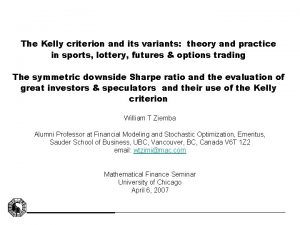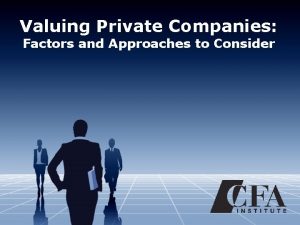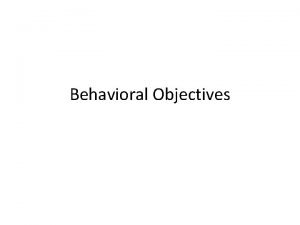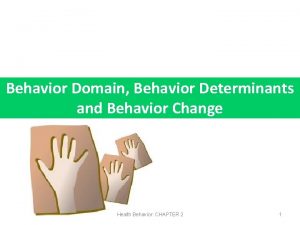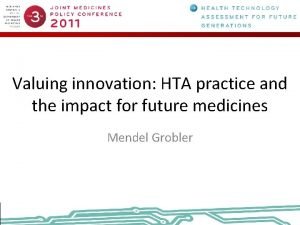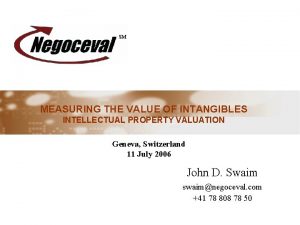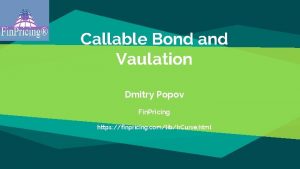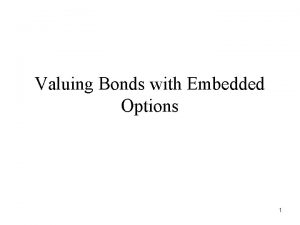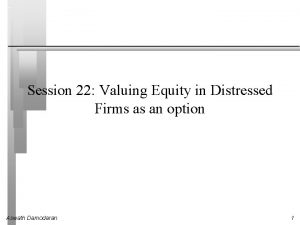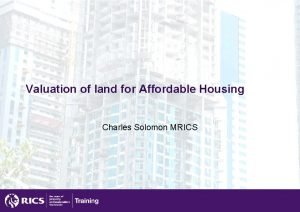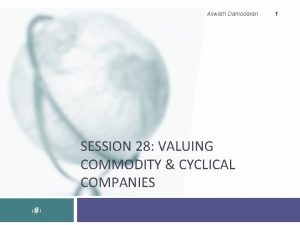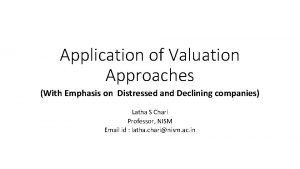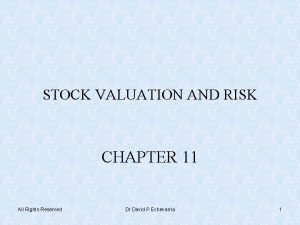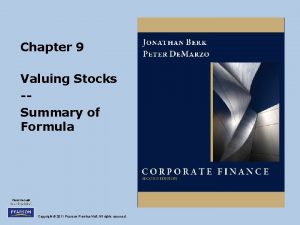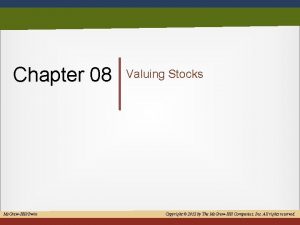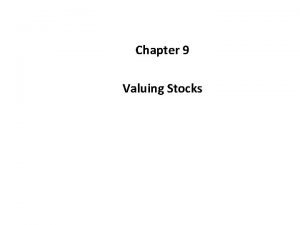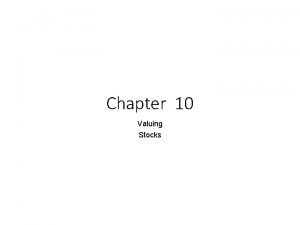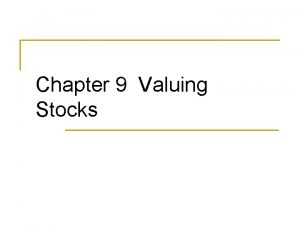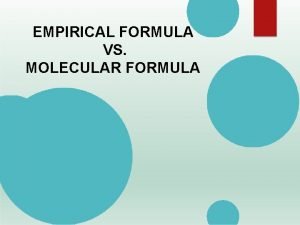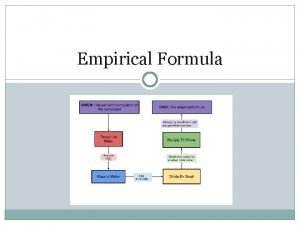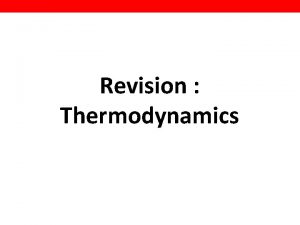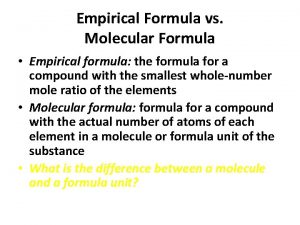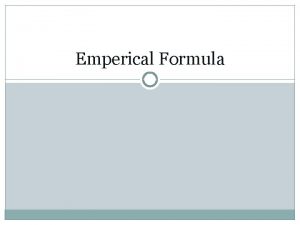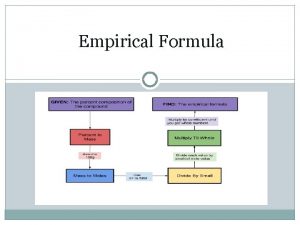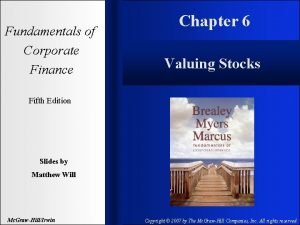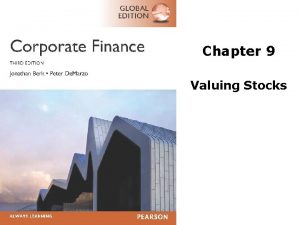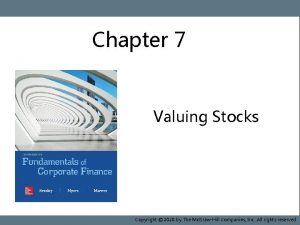Chapter 9 Valuing Stocks Summary of Formula Copyright


















- Slides: 18

Chapter 9 Valuing Stocks -Summary of Formula Copyright © 2011 Pearson Prentice Hall. All rights reserved.

Dividend Yields, Capital Gains, and Total Returns • Dividend Yield • Capital Gain – Capital Gain Rate • Total Return – Dividend Yield + Capital Gain Rate • The expected total return of the stock should equal the expected return of other investments available in the market with equivalent risk. Copyright © 2011 Pearson Prentice Hall. All rights reserved. 9 -2

The Dividend-Discount Model Equation • What is the price if we plan on holding the stock for N years? – This is known as the Dividend Discount Model. • Note that the above equation (9. 4) holds for any horizon N. Thus all investors (with the same beliefs) will attach the same value to the stock, independent of their investment horizons. Copyright © 2011 Pearson Prentice Hall. All rights reserved. 9 -3

The Dividend-Discount Model Equation (cont'd) • The price of any stock is equal to the present value of the expected future dividends it will pay. Copyright © 2011 Pearson Prentice Hall. All rights reserved. 9 -4

9. 2 Applying the Discount-Dividend Model (cont'd) • Constant Dividend Growth Model – The value of the firm depends on the current dividend level, the cost of equity, and the growth rate. Copyright © 2011 Pearson Prentice Hall. All rights reserved. 9 -5

Dividends Versus Investment and Growth • A Simple Model of Growth – Dividend Payout Ratio • The fraction of earnings paid as dividends each year Copyright © 2011 Pearson Prentice Hall. All rights reserved. 9 -6

Dividends Versus Investment and Growth (cont'd) • A Simple Model of Growth – If the firm keeps its retention rate constant, then the growth rate in dividends will equal the growth rate of earnings. Copyright © 2011 Pearson Prentice Hall. All rights reserved. 9 -7

Alternative Example 9. 4 • Problem – Dren Industries is considering expanding into a new product line. Earnings per share expected to be $5 in the coming year and are expected to grow annually at 5% without the new product line but growth would increase to 7% if the new product line is introduced. To finance the expansion, Dren would need to cut its dividend payout ratio from 80% to 50%. If Dren’s equity cost of capital is 11%, what would be the impact on Dren’s stock price if they introduce the new product line? Assume the equity cost of capital will remain unchanged. Copyright © 2011 Pearson Prentice Hall. All rights reserved. 9 -8

Alternative Example 9. 4 (cont’d) • Solution – First, calculate the current price for Dren if they do not introduce the new product. To calculate the price, D 1 is needed. To find D 1, EPS 1 is required: EPS 1 = EPS 0 × (1 + g) = $5. 00 × 1. 05 = $5. 25 D 1 = EPS 1 × Payout Ratio = $5. 25 × 0. 8 = $4. 20 P 0 = D 1/(r. E-g) = $4. 20/(. 11 -. 05) = $70. 00 – Thus, the current price without the new product should be $70 per share. Copyright © 2011 Pearson Prentice Hall. All rights reserved. 9 -9

Alternative Example 9. 4 (cont’d) • Solution – Next, calculate the expected current price for Dren if they introduce the new product: EPS 1 = EPS 0 × (1 + g) = $5. 00 × 1. 07 = $5. 35 D 1 = EPS 1 × Payout Ratio = $5. 35 × 0. 50 = $2. 675 P 0 = D 1/(r. E-g) = $2. 675/(. 11 -. 07) = $66. 875 – Thus, the current price is expected to fall from $70 to $66. 875 if the new product line is introduced. Copyright © 2011 Pearson Prentice Hall. All rights reserved. 9 -10

Changing Growth Rates (cont'd) • Dividend-Discount Model with Constant Long-Term Growth Copyright © 2011 Pearson Prentice Hall. All rights reserved. 9 -11

9. 3 Total Payout and Free Cash Flow Valuation Models (cont'd) • Share Repurchases and the Total Payout Model – Total Payout Model • Values all of the firm’s equity, rather than a single share. You discount total dividends and share repurchases and use the growth rate of earnings (rather than earnings per share) when forecasting the growth of the firm’s total payouts. Copyright © 2011 Pearson Prentice Hall. All rights reserved. 9 -12

The Discounted Free Cash Flow Model • Discounted Free Cash Flow Model – Determines the value of the firm to all investors, including both equity and debt holders – The enterprise value can be interpreted as the net cost of acquiring the firm’s equity, taking its cash, paying off all debt, and owning the unlevered business. Copyright © 2011 Pearson Prentice Hall. All rights reserved. 9 -13

The Discounted Free Cash Flow Model (cont'd) • Valuing the Enterprise – Free Cash Flow • Cash flow available to pay both debt holders and equity holders – Discounted Free Cash Flow Model Copyright © 2011 Pearson Prentice Hall. All rights reserved. 9 -14

The Discounted Free Cash Flow Model (cont'd) • Implementing the Model – Often, the terminal value is estimated by assuming a constant long-run growth rate g. FCF for free cash flows beyond year N, so that: Copyright © 2011 Pearson Prentice Hall. All rights reserved. 9 -15

Figure 9. 1 A Comparison of Discounted Cash Flow Models of Stock Valuation Copyright © 2011 Pearson Prentice Hall. All rights reserved. 9 -16

Valuation Multiples (cont'd) • Firms with high growth rates, and which generate cash well in excess of their investment needs so that they can maintain high payout rates, should have high P/E multiples. Copyright © 2011 Pearson Prentice Hall. All rights reserved. 9 -17

Valuation Multiples (cont'd) • Enterprise Value Multiples – This valuation multiple is higher for firms with high growth rates and low capital requirements (so that free cash flow is high in proportion to EBITDA). Copyright © 2011 Pearson Prentice Hall. All rights reserved. 9 -18
 Fractional kelly criterion
Fractional kelly criterion Valuing a private company
Valuing a private company 3 domains of learning
3 domains of learning Psychomotor objectives examples
Psychomotor objectives examples Covert behavior
Covert behavior Pericles describes athenian society as valuing
Pericles describes athenian society as valuing Resoect quotes
Resoect quotes Valuing innovation
Valuing innovation Valuation of ip
Valuation of ip Descriptive ethics vs normative ethics
Descriptive ethics vs normative ethics Vaulation
Vaulation Bonds with embedded options
Bonds with embedded options Valuing distressed companies
Valuing distressed companies Valuing culture
Valuing culture Valuing land for social housing
Valuing land for social housing Valuing cyclical companies
Valuing cyclical companies Valuing distressed and declining companies
Valuing distressed and declining companies A flavorful liquid made by gently simmering bones
A flavorful liquid made by gently simmering bones Dr david echevarria
Dr david echevarria
